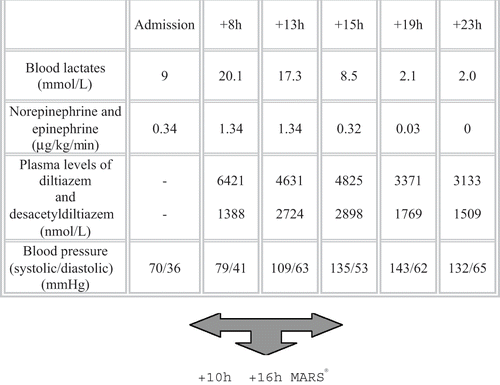To the Editor:
In their recent experimental study, Sen et al. (Citation1) showed that Molecular Adsorbents Recirculating System (MARS®) could remove efficiently both albumin and protein-bound drugs from the plasma. The authors herein report the first case of successful blood detoxification using MARS® therapy allowing full recovery in a patient presenting with a refractory shock secondary to acute diltiazem poisoning.
A depressive 55-year-old woman was admitted to our intensive care unit in shock 4 h after the intentional ingestion of 28 tablets of 300 mg sustained-release diltiazem. Upon admission, a severe hypotension (45/24 mmHg) was associated with bradycardia (56 bpm) and oliguria. The patient underwent immediate gastric lavage and received activated charcoal (50 g). Electrocardiogram recorded a sinus bradycardia associated with first-degree atrioventricular block. Despite aggressive fluid resuscitation (7000 mL), repeated intravenous injection of calcium (10 g) and glucagon (9 mg), and vasopressive support, the marked hypotension became refractory to increasing doses of vasopressors (epinephrine and norepinephrine: 1.34 μg/Kg/min). Transesophageal echocardiography depicted a mild-to-moderate left ventricular systolic dysfunction and no finding consistent with cardiac preload dependence. Eight hours after the admission, biological abnormalities were an acute renal failure (creatinine: 164 μmol/L) and a metabolic acidosis (pH: 7.03; bicarbonates: 7 mmol/L; base excess: -22 mmol/L) associated with high circulating lactate level (20.1 mmol/L). Serum diltiazem concentration was 6421 nmol/L (therapeutic range: 170–480 nmol/L).
Considering the deterioration of hemodynamics, despite aggressive resuscitation and the high proportion of circulating diltiazem (80% at therapeutic levels) bound to proteins (mainly albumin and alpha-1-acid glycoprotein) (Citation2), blood detoxification based on albumin dialysis using MARS® therapy was subsequently performed. Three hours after MARS® therapy initiation, blood samples were withdrawn every 2 h for 24 h to measure serum diltiazem and desacetyldiltiazem concentrations using liquid chromatography-diode array detection. During the procedure, blood lactate level declined, doses of vasopressors were rapidly tapered and definitely discontinued 6 h after the albumin dialysis initiation (). The patient fully recovered, and was discharged on day 5 with a normal transthoracic echocardiogram.
Severe calcium channel blocker overdose can result in marked and sustained hypotension (Citation3). Although hemodynamic side-effects of calcium channel blockers are potentially reversible, the mortality of severe diltiazem overdose remains as high as 10% (Citation3). As far as we know, no blood detoxification system has yet been shown to improve life-threatening circulatory failure secondary to severe overdose with calcium channel blockers (Citation4). The MARS® therapy is a new blood detoxification technique based on albumin dialysis, using a double-sided, albumin impregnated, hollow-fibre dialysis membrane as a molecular adsorbent in a closed-loop dialysis circuit (Citation5). Toxins that are normally degraded in the liver and not cleared by conventional hemodialysis can be selectively removed from the circulation using this system. Our case report shows that extracorporeal albumin dialysis using MARS® has the potential of efficiently removing protein-bound drugs from the circulation, thereby improving hemodynamic status. As such, this newly available system may be valuable in patients who sustain life-threatening hemodynamic compromise, despite symptomatic treatment in the setting of overdose from protein-binding drugs, that otherwise cannot be efficiently removed from the body.
REFERENCES
- Sen S, YtrebØ LM, Rose C, Fuskevaag OM, Davies NA, Nedredal GI, Williams R, Revhaug A, Jalan R. Albumin dialysis: a new therapeutic strategy for intoxication from protein-bound drugs. Intensive Care Med 2004; 30: 496–501, [PUBMED], [INFOTRIEVE]
- Bloedow DC, Piepho RW, Nies AS, Gal J. Serum binding of diltiazem in humans. J Clin Pharmacol 1982; 22: 201–205, [PUBMED], [INFOTRIEVE]
- Sauder P, Barriot P. Intoxications par les inhibiteurs calciques. intoxications aiguës en réanimation2nd, V Danel, P Barriot, 1999; 35, Editions Arnette Rueil-Malmaison
- Ramoska EA, Spiller HA, Winter M, Borys D. A one-year evaluation of calcium channel blocker overdoses: toxicity and treatment. Ann Emerg Med 1993; 22: 196–200, [PUBMED], [INFOTRIEVE], [CROSSREF]
- Kjaergard LL, Liu J, Als-Nielsen B, Gluud C. Artificial and Bioartificial Support Systems for acute and acute-on-chronic liver failure: a systematic review. JAMA 2003; 289: 217–222, [PUBMED], [INFOTRIEVE], [CROSSREF]
